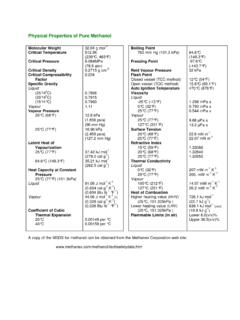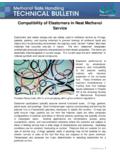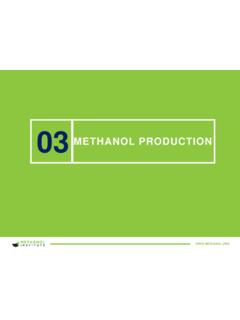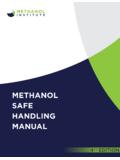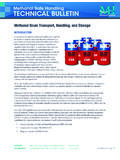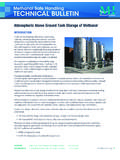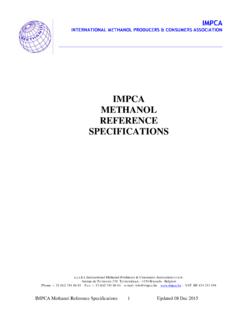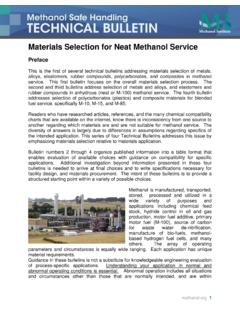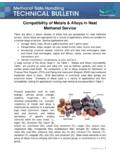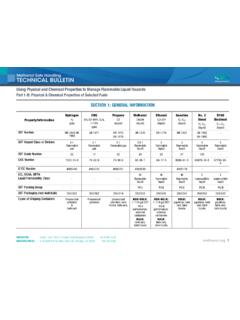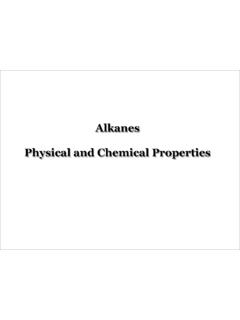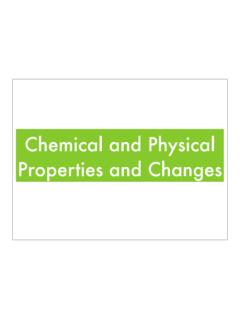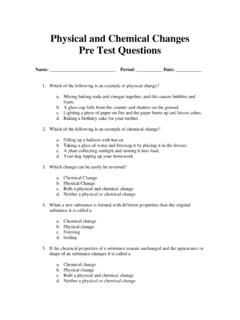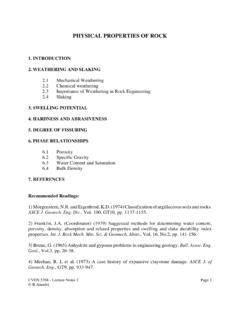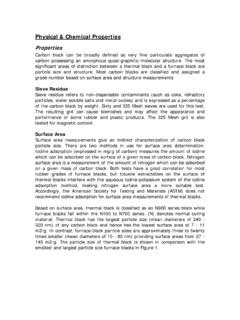Transcription of Using Physical and Chemical Properties to Manage …
1 SINGAPORE Suntec Tower Three 8 Temasek Blvd Singapore 038988 + WASHINGTON DC 4100 North Fairfax Drive, Suite 740, Arlington, VA 22203 1 Using Physical and Chemical Properties to Manage flammable Liquid Hazards Part Three of a Three Part Series1 INTRODUCTION This is the last section of the three-part Technical Bulletin, which provides guidance for Using Physical , Chemical , thermal, and electrical Properties to identify and control hazards of flammable liquids. Eight fuels [hydrogen, compressed natural gas, propane (a compressed gas), methanol, ethanol, gasoline, No. 2 diesel, and biodiesel] are used as examples. The table in Part 1-B lists the Physical and Chemical Properties of these PRINCIPLES OF IGNITION AND COMBUSTION Combustion is a Chemical oxidation process that requires formation of Chemical radicals by transfer of electrons between an oxidizing agent (21 v% oxygen in air) and reducing agents ( flammable liquids).
2 Three conditions are necessary for ignition to occur. A fourth condition is necessary for combustion to occur, and a fifth condition is necessary for fire propagation. 1) A fuel must be present ( , methanol) 2) An oxidizer must be present (21 v% oxygen as air) 3) A source of ignition must be present with sufficient energy to initiate formation of Chemical radicals 4) A Chemical chain reaction must occur which generates an exponentially increasing number of Chemical radicals which sustain the combustion process and cause the fire to release increasing amounts of heat. 5) Heat released by the exothermic combustion reaction must be sufficient to pre-heat and ignite surrounding material. Vapors burn, while liquids do not. flammable and combustible liquids must be heated to a temperature at which sufficient vapor is generated at the liquid surface to enable ignition and then support combustion. The temperature at which ignition occurs is the flash point temperature.
3 Flash point temperature is determined in the laboratory by standardized experimental testing. Fuels ignite but do not combust at their flash point temperature. 1) flammable liquids must have sufficient energy (measured as temperature) to release a sufficient amount of vaporized fuel (vapor in equilibrium with the liquid) to support combustion. This temperature is termed the flame point temperature of the liquid. In practical terms, flash point temperature is used instead of flame point temperature to assess likelihood of ignition. Flame point temperature is typically 10 15 oF higher than the flash temperature for most flammable liquids. The flash point temperature is the minimum temperature at which ignition can occur, but does not generate sufficient vapor to support combustion 1 This three-part Technical Bulletin was written by Mr.
4 Robert R. Roberts of Roberts & Roberts Risk & Reliability Engineering and edited by Alliance Consulting International, San Diego, California under contract to the Methanol Institute. 2 Information and data are collected from a variety of published and internet sources, though different sources may contain conflicting data regarding the same information. Effort has been made to use reliable sources; however, no responsibility is taken for correctness, accuracy, or errors in information. Using Physical and Chemical Properties to Manage flammable Liquid Hazards Part Three of a Three Part Series SINGAPORE Suntec Tower Three 8 Temasek Blvd Singapore 038988 + WASHINGTON DC 4100 North Fairfax Drive, Suite 740, Arlington, VA 22203 2 2) The molar or volumetric concentration of flammable vapor in air must be within the flammable range of that specific liquid 3) Fuel molecules must be mixed and have intimate contact with oxygen molecules within the surrounding air 4) An ignition source must be active and transfer sufficient energy to the vapor/air mixture to initiate a chain reaction.
5 Alternately, the fuel/air mixture must be in contact with a surface above the autoignition temperature of the fuel 5) The exothermic combustion chain reaction must release sufficient heat to propagate ignition, thereby sustaining combustion The energy source that causes ignition can be auto-ignition ( , a hot surface or hot air), or induced or piloted ignition ( , a spark, an electric arc, or an open flame). Regardless of whether ignition is auto- or induced, the ignition source must be sufficiently energetic to raise the temperature of an infinitesimally small mixture of fuel and air to the fuel s ignition temperature. The ignition temperature is the temperature at which covalently-bonded molecules of fuel and oxygen begin to spontaneously transform into positively and negatively charged radicals which then recombine as combustion products ( , CO, CO2 and H2O), thereby releasing heat. If an ignition source is sufficiently energetic to drive the rate of formation of free Chemical radicals to the point at which the exothermic heat of reaction of combustion products generates a sustainable, exponentially accelerating number of positively and negatively-charged radicals, then combustion has occurred, flames and heat are generated, and a fire begins to burn.
6 If the chain reaction continues unchecked, then combustion occurs and the fire gets larger. Once combustion occurs, flames spread and grow in size as a kinetic process characteristic of exponential chain reactions. Fire propagation will continue as long as there is unburned fuel, or until the fire is extinguished by external intervention. The rate at which fuel is converted (burned) is termed the mass burning rate. If the mass burning rate, the surface area of the pool, and the lower heating value (LHV) of the fuel are known, then it is possible to estimate the rate of radiant heat flux from the fire. TYPES OF FIRES AND FIRE HAZARDS Fires are generally classified as belonging to one of four categories: 1) Pool fires- resulting from spills, leaks, and condensation of vapor from pressure flashing liquids 2) Jet fires- resulting from a pressurized containment vessel or pipe into free air 3) Flash fires- occurs when a cloud of flammable gas is ignited 4) Fireball- fireballs occur when a quantity of flammable liquid or gas suddenly releases from pressurized containment and is immediately ignited as in boiling liquid expanding vapor explosions (BLEVEs) Behavior of pool fire flames is entirely under the influence of their own buoyancy; flames are easily displaced by wind and can change shape rapidly and unexpectedly.
7 Jet fires typically have a long flame which is unaffected by wind. Fire duration is dependent on release rate and pressure of the exiting fluid at the point of release. The shape of flash fires is determined by the shape of the flammable cloud and the position of the cloud relative to the location of the ignition source. Flash fires are usually short in duration and are known to flash back to the source of fuel vapor, be that a pool, or a jet release. When flame speed and fire propagation are slow then deflagration occurs and Using Physical and Chemical Properties to Manage flammable Liquid Hazards Part Three of a Three Part Series SINGAPORE Suntec Tower Three 8 Temasek Blvd Singapore 038988 + WASHINGTON DC 4100 North Fairfax Drive, Suite 740, Arlington, VA 22203 3 overpressure is small. When flame speed is high, approaching sonic velocity (1,126 ft/s @ NTP) the deflagration transitions to an explosion, and overpressure becomes an additional consideration for life safety and damage.
8 Overpressure estimation should be performed by someone who is trained in that subject matter. The hazard of pool, jet, flash, and fireball fires is primarily exposure to radiant heat flux. Exposure to kW/m2 will result in instantaneous death. Safe exposure levels are typically around 5 kw/m2. Phani K. Raj provides a summary of radiant heat exposure criteria in a 2007 article in Journal of Hazardous A brief summary of overpressure effects on humans is summarized by The Institution of Chemical POINT SOURCE MODEL FOR ESTIMATING RADIANT HEAT FLUX A point source model can be used as a quick and simple method of estimating thermal radiation. The point source model assumes heat of combustion radiates in all directions equally from a single point. The total heat available for transfer by radiation is calculated as the product of the fuel mass burn rate (a characteristic parameter of each particular fuel), the surface area of burning fuel (not the surface area of the flames), and the LHV for the fuel (preferably the heat release rate of vapor reacting to form non-condensable gaseous combustion products and water vapor).
9 Incident radiant heat flux (I) at any distance from a pool fire is determined as I = _f (LHV as Btu/lb) 4 d2 where f is the fraction of the heat which is released (use f = 1 to determine an upper bound), LHV is the heat released when a pound of fuel vapor is converted to gas and vapor combustion products, and d (in feet) is the radius at which one wishes to estimate incident heat flux. A disadvantage of the point source model is that it underestimates incident radiation levels for distances within two diameters of the fire. More refined point source methods are also Behavior of liquid pool fires can be useful in first order estimation of heat flux from large fireballs since both pool fires and fireballs are buoyancy dominated. Fireballs with maximum diameter of 30 to 35 feet have measured surface emissive power of 185 to 224 kW/m2. Larger fireballs can be approximated Using values of surface emissive power between 250 and 300 kW/m2.
10 Calculating incident radiation levels for fireballs is complicated and depends heavily on the value selected for the emissive power of the fireball. It is recommended that users enlist the assistance of a qualified consultant if second order results are required for radiant heat flux from fireballs. In small fires, heat is released by conduction, convection, and radiant heat transfer processes. Heat release in large fires (> 1-2 feet diameter) is primarily by radiant heat transfer. Radiant heat flux determines the radius of the hazard zone for a fire. The radius of the hazard zone for overpressure must be determined separately. 3 Article by Pani K. Raj, A Review of Criteria for People Exposure to Radian Heat Flux from Fires, available on as of March 2011 4 Institution of Chemical Engineers: The Effects of Explosions in the Process Industries, Overpressure Monograph, First paper of the Major Hazards Assessment Panel Overpressure working party, 1989 by The Institution of Chemical Engineers, p.
